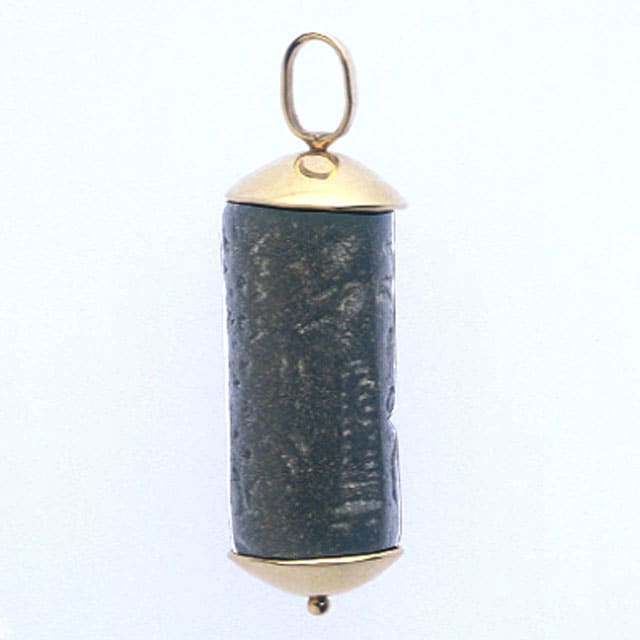Gold Pendant Featuring a Black Diorite Cylinder Seal, 1900 BCE - 1300 BCE
Diorite/Gold
FJ.5466
This genuine ancient cylinder seal has been mounted in a modern 18 karat gold pendant. As their name implies, cylinders seals are cylinders, generally of stone, that were carved with...
This genuine ancient cylinder seal has been mounted in a modern 18 karat gold pendant.
As their name implies, cylinders seals are cylinders, generally of stone, that were carved with a design so that when they are rolled out on clay a continuous impression in relief is produced. They were usually pierced lengthwise so that they could be worn on a pin or string, or mounted on a swivel. Cylinder seals were developed during the second half of the fourth millennium B.C. in southern Mesopotamia and in southwestern Iran as a convenient way of covering large areas of clay used for sealing storeroom locks, goods carried in jars, bags, boxes or baskets and--above all--the clay tablets used for about 3,000 years as the main vehicle for cuneiform writing. The designs on cylinder seals are a valuable source of information for scholars today. They chronicle developments in the iconography of deities, mythology and daily life as well as recording special events. This extraordinary cylinder seal features the image of a seated figure, perhaps a ruler or an ancient god. Standing in front of the seated figure are two other figures that appear to be bringing offerings to the seated ruler or god. Whatever the ancient symbolism represented in this seal, it is an extraordinary work of art in its own right, evidencing the aesthetic sensibilities of a culture whose legacy includes not only fine artworks such as this but also the very origins of writing itself.
As their name implies, cylinders seals are cylinders, generally of stone, that were carved with a design so that when they are rolled out on clay a continuous impression in relief is produced. They were usually pierced lengthwise so that they could be worn on a pin or string, or mounted on a swivel. Cylinder seals were developed during the second half of the fourth millennium B.C. in southern Mesopotamia and in southwestern Iran as a convenient way of covering large areas of clay used for sealing storeroom locks, goods carried in jars, bags, boxes or baskets and--above all--the clay tablets used for about 3,000 years as the main vehicle for cuneiform writing. The designs on cylinder seals are a valuable source of information for scholars today. They chronicle developments in the iconography of deities, mythology and daily life as well as recording special events. This extraordinary cylinder seal features the image of a seated figure, perhaps a ruler or an ancient god. Standing in front of the seated figure are two other figures that appear to be bringing offerings to the seated ruler or god. Whatever the ancient symbolism represented in this seal, it is an extraordinary work of art in its own right, evidencing the aesthetic sensibilities of a culture whose legacy includes not only fine artworks such as this but also the very origins of writing itself.
